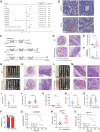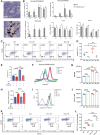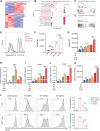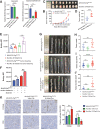Long Noncoding RNA MIR4435-2HG Suppresses Colorectal Cancer Initiation and Progression By Reprogramming Neutrophils
- PMID: 35862232
- PMCID: PMC9433964
- DOI: 10.1158/2326-6066.CIR-21-1011
Long Noncoding RNA MIR4435-2HG Suppresses Colorectal Cancer Initiation and Progression By Reprogramming Neutrophils
Abstract
MIR4435-2HG, also known as LINC00978, has previously been described as an oncogenic long noncoding RNA (lncRNA). However, we show here that Mir4435-2hg depletion promoted colorectal tumorigenesis and progression in in vivo models of colitis-associated colorectal cancer, spontaneous intestinal adenomatous polyposis, and subcutaneous tumors. Alteration of MIR4435-2HG in colorectal cancer cells did not change the potential for cell proliferation, migration, or invasion in vitro. RNAscope assays showed that most MIR4435-2HG was located in the tumor stroma, which caused high expression of MIR4435-2HG in colorectal cancer tumor tissue. Transcriptome analysis of colorectal cancer tissues from wild-type and Mir4435-2hg-deficient mice revealed Mir4435-2hg as a tumor suppressor gene that regulated the immune microenvironment. Loss of Mir4435-2hg led to a decline in neutrophils and elevation of polymorphonuclear myeloid-derived suppressor cells (PMN-MDSC). In tissue-specific Mir4435-2hg knockout mice, we confirmed that Mir4435-2hg depletion in neutrophils, but not in intestinal epithelial cells, promoted colorectal cancer progression. Mechanistically, Mir4435-2hg depletion enhanced the immunosuppressive ability of PMN-MDSCs by disturbing their fatty acid metabolism. These findings suggest that MIR4435-2HG is a tumor-suppressing lncRNA whose deficiency could increase tumor-infiltrating PMN-MDSCs and enhance the immunosuppressive potential of PMN-MDSCs to promote colorectal cancer development. This provides a theoretical basis for further illustrating the pathogenesis of colorectal cancer and a potential antitumor immunotherapy target.
©2022 The Authors; Published by the American Association for Cancer Research.
Figures






Similar articles
-
LncRNA MIR4435-2HG contributes into colorectal cancer development and predicts poor prognosis.Eur Rev Med Pharmacol Sci. 2020 Feb;24(4):1771-1777. doi: 10.26355/eurrev_202002_20354. Eur Rev Med Pharmacol Sci. 2020. PMID: 32141545
-
LncRNA MIR4435-2HG drives cancer progression by modulating cell cycle regulators and mTOR signaling in stroma-enriched subtypes of urothelial carcinoma of the bladder.Cell Oncol (Dordr). 2023 Oct;46(5):1509-1527. doi: 10.1007/s13402-023-00826-5. Epub 2023 Jun 24. Cell Oncol (Dordr). 2023. PMID: 37355516 Free PMC article.
-
lncRNA MIR4435-2HG promoted clear cell renal cell carcinoma malignant progression via miR-513a-5p/KLF6 axis.J Cell Mol Med. 2020 Sep;24(17):10013-10026. doi: 10.1111/jcmm.15609. Epub 2020 Jul 30. J Cell Mol Med. 2020. PMID: 33460239 Free PMC article.
-
MIR4435-2HG: A Tumor-associated Long Non-coding RNA.Curr Pharm Des. 2022;28(25):2043-2051. doi: 10.2174/1381612828666220607100228. Curr Pharm Des. 2022. PMID: 35674305 Review.
-
MIR4435-2HG: A newly proposed lncRNA in human cancer.Biomed Pharmacother. 2022 Jun;150:112971. doi: 10.1016/j.biopha.2022.112971. Epub 2022 Apr 18. Biomed Pharmacother. 2022. PMID: 35447550 Review.
Cited by
-
Biological Roles and Pathogenic Mechanisms of LncRNA MIR4435-2HG in Cancer: A Comprehensive Review.Curr Issues Mol Biol. 2023 Nov 4;45(11):8864-8881. doi: 10.3390/cimb45110556. Curr Issues Mol Biol. 2023. PMID: 37998733 Free PMC article. Review.
-
The role of innate immune cells in the colorectal cancer tumor microenvironment and advances in anti-tumor therapy research.Front Immunol. 2024 Jul 19;15:1407449. doi: 10.3389/fimmu.2024.1407449. eCollection 2024. Front Immunol. 2024. PMID: 39100676 Free PMC article. Review.
-
Recent developments in immunotherapy for gastrointestinal tract cancers.J Hematol Oncol. 2024 Aug 9;17(1):65. doi: 10.1186/s13045-024-01578-x. J Hematol Oncol. 2024. PMID: 39123202 Free PMC article. Review.
-
Decoding the regulatory landscape of lncRNAs as potential diagnostic and prognostic biomarkers for gastric and colorectal cancers.Clin Exp Med. 2024 Jan 31;24(1):29. doi: 10.1007/s10238-023-01260-5. Clin Exp Med. 2024. PMID: 38294554 Free PMC article. Review.
-
Crosstalk between GLTSCR1-deficient endothelial cells and tumour cells promotes colorectal cancer development by activating the Notch pathway.Cell Death Differ. 2025 Jul;32(7):1231-1243. doi: 10.1038/s41418-025-01450-6. Epub 2025 Jan 27. Cell Death Differ. 2025. PMID: 39870803
References
-
- Mercer TR, Dinger ME, Mattick JS. Long non-coding RNAs: insights into functions. Nat Rev Genet 2009;10:155–9. - PubMed
-
- Siegel RL, Miller KD, Fuchs HE, Jemal A. Cancer statistics, 2021. CA Cancer J Clin 2021;71:7–33. - PubMed
-
- Kong J, Sun W, Li C, Wan L, Wang S, Wu Y, et al. . Long non-coding RNA LINC01133 inhibits epithelial–mesenchymal transition and metastasis in colorectal cancer by interacting with SRSF6. Cancer Lett 2016;380:476–84. - PubMed
Publication types
MeSH terms
Substances
LinkOut - more resources
Full Text Sources
Medical

